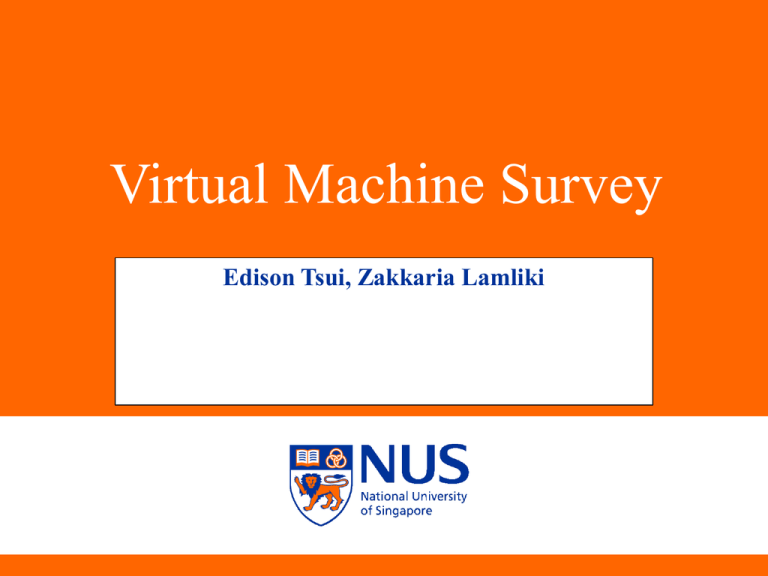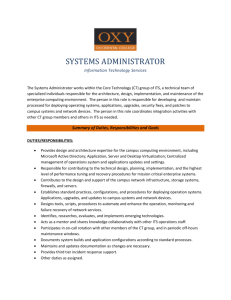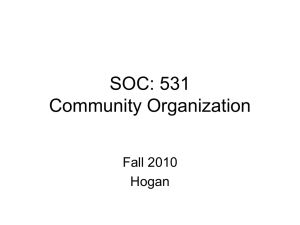Virtual Machine Survey
advertisement

Virtual Machine Survey Edison Tsui, Zakkaria Lamliki SoC Presentation Title 2004 Rundown Introduction of VMM Benefit Classification Virtualization Requirement & Technique CPU Virtualization Pure Virtualization, Binary Translation, Para-virtualization…. Memory Virtualization I/O Virtualization Security Opportunity and Challenges Conclusion SoC Presentation Title 2004 Introduction What is virtualization Machine Monitor (VMM) A thin layer of software in the middle of OS and Hardware OS OS VMM Allow running multiple guest OS on top of single piece of hardware Hardware Hardware SoC Presentation Title 2004 Benefit from Virtualization Utilization of hardware From “one-service-one-machine” to multiplex multiple services in one machine Isolation Ease of Management Migration Checkpoint and Rollback Compatibility Software Distribution SoC Presentation Title 2004 Classification Type 1 on the host’s hardware higher virtualization Example LDom, LPAR, VMware ESX SoC Presentation Title 2004 Classification Type 2 on conventional OS support of a broad range of I/O devices Example VirtualBox Parallels Workstation SoC Presentation Title 2004 Classification Hybrid Type Combination of robustness of the type 1 model flexibility of the type 2 model SoC Presentation Title 2004 Virtualization Requirement Popek and Goldberg Equivalency Efficiency Resource Control SoC Presentation Title 2004 CPU Virtualization Impact of bringing in VMM De-privilege Less Privileged Level Most Privileged Level SoC Presentation Title 2004 CPU Virtualization Executing Non-privileged Instruction Behave the same Case 1: Non-privileged Instruction Less Privileged Level Most Privileged Level SoC Presentation Title 2004 CPU Virtualization Executing Privileged Instruction Processor will trap back to VMM VMM can emulate Case 2: Privileged Instruction Trap and Emulate Less Privileged Level Most Privileged Level SoC Presentation Title 2004 CPU Virtualization Executing Sensitive but non-privileged instruction Behave differently under different Privilege Level Case 3: Sensitive but non-privileged Instruction Less Privileged Level Potential Problem Most Privileged Level SoC Presentation Title 2004 CPU Virtualization Pure virtualization Processor Instruction Set is fully virtualizable “a CPU architecture is virtualizable if the set of sensitive instructions is a subset of privileged instructions” [3] SoC Presentation Title 2004 CPU Virtualization Pure Virtualization Advantage Guest OS can run on VMM without modification Challenges Not all processor instruction set are virtualizable, including x86 Heavy overhead when switching between privilege levels SoC Presentation Title 2004 CPU Virtualization Binary Translation [33], [13] replace binary code that cannot be directly executed on the fly PC-relative addressing Direct control flow Indirect control flow Privileged instructions Other code block remain identical SoC Presentation Title 2004 CPU Virtualization Case Study Execute Translator Translation Unit (TU) in binary Compiled Code Fragment (CCF) SoC Presentation Title 2004 CPU Virtualization Binary Translation Advantage Guest OS kernel do not need to be modified Disadvantage The translation can be complicated SoC Presentation Title 2004 CPU Virtualization Para-virtualization[11][12] Introduce co-design of VMM and guest OS kernel Guest OS kernel need to be modified to handle sensitive but non-privileged instructions avoid frequent trap into hypervisor for better performance SoC Presentation Title 2004 CPU Virtualization Pre-virtualization Advantage Better performance Disadvantage Compatibility Unmodified guest OS cannot run on top of VMM Modified guest OS cannot run on native hardware Engineering Effort Degree of engineering effort varies from projects SoC Presentation Title 2004 CPU Virtualization Pre-virtualization[16][17] Soft-layering principle In-place VMM (IPVMM) to mediate Guest OS and VMM Well defined basis for kernel modification Can be automated SoC Presentation Title 2004 CPU Virtualization Pre-virtualization Advantage Compatibility Lower Engineering Cost Disadvantage Overhead form IPVMM SoC Presentation Title 2004 CPU Virtualization Hardware-assisted SoC Presentation Title 2004 Memory Virtualization SoC Presentation Title 2004 I/O Virtualization SoC Presentation Title 2004 Security Aspect Opportunity Can VMM bring better security? Intrusion Detection System (IDS) Trusted VMM Simple Example Utilize VMM isolation property Specify a VM for online-banking SoC Presentation Title 2004 Security Opportunity: Intrusion Detection System Traditional IDS trade off Visibility Ability to inspect hardware and guest OS software state and event Isolation Ability to be isolated from malware attack Traditional IDS reside in Network Host OS VMM can provide better visibility and isolation Simple and Constrained Interface Simple Protection Mode Simple architecture and small code size SoC Presentation Title 2004 Security Opportunity: Intrusion Detection System Example LiveWire[24] SoC Presentation Title 2004 Security Challenge Malware Virtual Machine Based RootKit (VMBR) Layer-below attack Hardware Virtual Machine based RootKit (HVM Rootkit) Claim impossible for detection BluePill [39] SoC Presentation Title 2004 Security Challenge VMBR Detection & Defense Side Channel Information RedPill [40] (apply to VMBR only) Sensitive but non-privilege instruction, e.g. SIDT VMBR can be avoided by installing VMM beforehand SoC Presentation Title 2004 Security Challenge New User behavior and management issue Patch Management Rollback Problem State is kept unchanged Possible seed reuse Data Mobility SoC Presentation Title 2004 Q &A SoC Presentation Title 2004 Reference [1] R.P. Goldberg, “Survey of Virtual Machine Research”, 1974 [2] M Rosenblum, T Garfinkel, “Virtual Machine Monitors: Current Technology and Future Trends”- Computer, 2005 - ieeexplore.ieee.org [3] Gerald J. Popek and Robert P. Goldberg. Formal requirements for virtualizable third generation architectures. Communications of the ACM, 17(7):412–421, 1974. [4] JE Smith, R Nair , “The architecture of virtual machines”, Computer, 2005 - ieeexplore.ieee.org [5] R Rose, “Survey of system virtualization techniques”, Retrieved March, 2004 - robertwrose.com [6] Poul-Henning Kamp Robert N. M. Watson, “Jails: Confining the omnipotent root”. [7] Khairil Yusof ,“FreeBSD Jails: Lightweight Virtualization”. [8] Octave Orgeron (Sun Microsystem) “An introduction to Logical Domains.” [9] Menno Lageman, “Sun Client Solutions : Solaris Containers — What They Are and How to Use Them” [10] E Bugnion, S Devine, K Govil, M Rosenblum , “Disco: Running commodity operating systems on scalable multiprocessors”, ACM Transactions on Computer Systems, 1997 - portal.acm.org [11] P Barham, B Dragovic, K Fraser, S Hand, T Harris , “Xen and the art of virtualization”, ACM SIGOPS Operating Systems Review, 2003 - portal.acm.org [12] Andrew Whitaker, Marianne Shaw, and Steven D. Gribble. Scale and performance in the denali isolation kernel. ACM SIGOPS Operating Systems Review, 36(SI):195–209, 2002. [13] K Adams, O Agesen“A comparison of software and hardware techniques for x86 virtualization”, 2006 - portal.acm.org [14] Rich Uhlig, Gil Neiger, Dion Rodgers, Amy L. Santoni, Fernando C. M. Martins, Andrew V. Anderson, Steven M. Bennett, Alain Kagi, Felix H. Leung, and Larry Smith. Intel virtualization technology. IEEE Computer, 38(5):48–56, 2005. [15] Advanced Micro Devices, Inc. AMD64 Virtualization Codenamed Pacifica Technology, Secure Virtual Machine Architecture Reference Manual. Austin, TX, USA, 2006. [16] J LeVasseur, V Uhlig, B Leslie, M Chapman, G Heiser, “Pre-virtualization: uniting two worlds”, Proceedings of the twentieth ACM symposium on Operating systems principles [17] J LeVasseur, V Uhlig, B Leslie, M Chapman, G Heiser, “Pre-virtualization: software layering for virtual machine” [18] Logical Domains 1.0.3 Admin Guide [19] Ashley Saulsbury, “UltraSPARC Virtual Machine Specification” [20] J. P. Casazza, M. Greenfield, and K. Shi, “Redefining Server Performance Characterization for Virtualization Benchmarking”, Intel Technology Journal, 2006, 10(3):243-252. [21] D. Gupta, R. Gardner, and L. Cherkasova, “XenMon: QoS monitoring and performance profiling tool”, HP Labs Technical Report, HPL-2005-187, October 2005. [22] Menon, JR Santos, Y Turner, GJ Janakiraman, Willy Zwaenepoel , “Diagnosing performance overheads in the xen virtual machine environment”, usenix.org [23] Diwaker Gupta (UC San Diego), Lucy Cherkasova (HP Labs), Rob Gardner (HP Labs), Amin Vahdat (UC San Diego), “Performance Isolation in XEN”. [24] T Garfinkel, M Rosenblum , “A virtual machine introspection based architecture for intrusion detection”, Proc. Network and Distributed Systems Security Symposium, 2003 - eprints.kfupm.edu.sa [25] T Garfinkel, B Pfaff, J Chow, M Rosenblum, D Boneh , “Terra: A virtual machine-based platform for trusted computing” - portal.acm.org [26] ST King, PM Chen , “SubVirt: Implementing malware with virtual machines” - 2006 IEEE Symposium on Security and Privacy, 2006 - ieeexplore.ieee.org [27] GW Dunlap, ST King, S Cinar, MA Basrai, PM Chen , “ReVirt: Enabling intrusion analysis through virtual-machine logging and replay”,- ACM SIGOPS Operating Systems Review, 2002 - portal.acm.org [28] C SE, Y RESPONSE , “A Testing Methodology for Rootkit Removal Effectiveness”, symantec.com [29] T Garfinkel, M Rosenblum, “When Virtual is harder than Real: Security Challenges in Virtual Machine Based Computing Environments” [30] J. S. Robin, C. E. Irvine, “Analysis of the Intel Pentium Ability to support a Secure Virtual Machine Monitor”, USENUX Security Symposium, pp 129-144, 2000 [31] R. Goldberg. Architectural Principles for Virtual Computer Systems. Ph.D. thesis, Harvard University, Cambridge, MA, 1972. [32] R. J. Creasy, “The Origin of the Vm/370 Time-Sharing System”, IBM Journal of Research and Development, vol 25, no 5, p 483, 1981 [33] R. Sites er al., “Binary Translation”, Comm, ACM, Feb 1993, pp 69-81 [34] Tony Shoumack, “BEGINNERS GUIDE TO LDOMS: UNDERSTANDING AND DEPLOYING LOGICAL DOMAINS" [35] T Garfinkel, K Adams, A Warfield, J Franklin , “Compatibility is not transparency: VMM detection myths and realities” - Proceedings of the 11th Workshop on Hot Topics in Operating System usenix.org [36] K Skapinetz, “Virtualisation as a blackhat tool”, Network Security, Oct 2007 [37] KG Anagnostakis, S Sidiroglou, P Akritidis, K Xinidis, E Markatos, “Detecting targeted attacks using shadow honeypots”, - usenix.org [38] A Joshi, ST King, GW Dunlap, PM Chen , “Detecting past and present intrusions through vulnerability-specific predicates”, - Proceedings of the twentieth ACM symposium on Operating System Principles, pp 91-104, 2005 - portal.acm.org [39] Blue Pill Project, www.bluepillproject.org, Invisible Things Lab [40] J. Rutkowska, “Red Pill or how to detect VMM using (almost) one CPU instruction”, 2005 [41] P. Ferrie, N. Lawason, T. Ptacek, “Don’t Tell Joanna, The Virtualised Rootkit Is Dead” In Proceedings of Black Hat USA 2007, [42] A. Seshadri, M. Luk, E. Shi, A. Perrig, L. van Doorn, and P. Khosla. Pioneer: Verifying integrity and guaranteeing execution of code on legacy platforms. In Proceedings of ACM Symposium on Operating Systems Principles (SOSP), pages 1–16, 2005 [43] Y.-M. Wang, D. Beck, B. Vo, R. Roussev, and C. Verbowski. Detecting Stealth Software with Strider GhostBuster. In Proceedings of the 2005 International Conference on Dependable Systems and Networks (DSN), June 2005. [44] M Carbone, D Zamboni, W Lee, “Taming Virtualization”, - IEEE Security & Privacy, 2008 - ieeexplore.ieee.org






